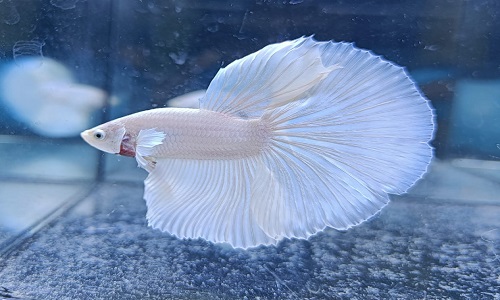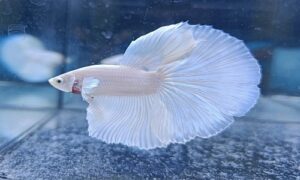
Introduction

Betta fish, also known as Siamese fighting fish, are popular aquarium pets known for their vibrant colors and long flowing fins. However, despite their popularity, betta fish can be prone to various health issues that may lead to their untimely demise.
Here are some common reasons why betta fish may keep dying:
Poor Water Quality:
Betta fish are sensitive to changes in water conditions, including ammonia, nitrites, and nitrates levels. High levels of these compounds can result from overfeeding, inadequate filtration, or infrequent water changes, leading to stress, illness, and ultimately death.
Overfeeding:
Feeding betta fish excessively or providing inappropriate food types can lead to digestive issues and water pollution. Uneaten food can decompose, causing ammonia spikes and deteriorating water quality, which can stress and harm the fish.
Inadequate Tank Size:
Betta fish require adequate space to swim and thrive. Keeping them in small, cramped tanks or bowls can lead to stress, stunted growth, and susceptibility to diseases. A minimum tank size of 5 gallons is recommended for betta fish to ensure proper water parameters and ample swimming space.
Poor Water Temperature:
Betta fish are tropical fish and require stable water temperatures between 75°F and 82°F (24°C and 28°C). Fluctuations in temperature or exposure to extreme temperatures can weaken their immune system, making them more susceptible to diseases and stress-related issues.
Lack of Oxygenation:
Betta fish require well-oxygenated water to breathe properly. Inadequate aeration, such as lack of surface agitation or oxygen exchange, can lead to oxygen deprivation and stress, especially in tanks with poor filtration or stagnant water conditions.
Aggressive Tankmates:
Despite their name, betta fish can be aggressive toward other fish, especially males. Keeping them with incompatible tankmates or in overcrowded conditions can lead to territorial disputes, injuries, and stress, ultimately resulting in fatalities.
Poor Water Chemistry:
In addition to ammonia, nitrites, and nitrates, other water chemistry parameters such as pH and hardness can impact betta fish health. Sudden changes or extremes in pH levels or water hardness can stress the fish and compromise their immune system, making them more susceptible to diseases.
Disease and Parasites:
Betta fish are prone to various diseases and parasitic infections, including fin rot, ich, velvet, and bacterial infections. These conditions can be caused by poor water quality, stress, or exposure to pathogens from contaminated tank decorations or new fish introductions.
Stress:
Betta fish are sensitive creatures that can become stressed due to environmental changes, handling, or aggressive behavior from tankmates. Prolonged stress weakens their immune system and makes them more susceptible to diseases and health issues.
Old Age:
Like all living organisms, betta fish have a natural lifespan. While proper care can prolong their lifespan, eventually, they may succumb to old age-related health issues.
Origins and History:
- Native Habitat: Betta fish originate from the shallow waters of rice paddies, streams, and floodplains in Southeast Asia, primarily Thailand, Cambodia, Vietnam, and Malaysia.
- Historical Significance: Initially bred for their aggressive nature and fighting abilities, bettas were used in traditional Siamese fish fighting competitions, which led to their common name, Siamese fighting fish.
- Domestication: Over time, selective breeding has produced a wide array of color variations and fin types, transforming bettas into popular aquarium pets prized for their beauty and elegance.
Physical Characteristics:
- Color Varieties: Betta fish exhibit a stunning array of colors, including vibrant hues of red, blue, green, purple, and even metallic shades.
- Fin Types: Betta fins can be long and flowing, short and rounded, or somewhere in between. Common fin types include veiltail, crowntail, halfmoon, plakat, and double tail.
- Size: Adult bettas typically grow to 2.5 to 3 inches in length, with males often exhibiting larger fins and more intense colors than females.
Behavior and Temperament:
- Aggression: Male bettas are known for their territorial and aggressive nature, especially toward other males. They may flare their gills, display vibrant colors, and engage in fin displays as a part of territorial disputes.
- Solitary Nature: Due to their aggressive tendencies, male bettas are best kept alone in aquariums. Females can coexist peacefully in small groups known as sororities, although proper tank setup and monitoring are crucial to prevent aggression.
- Interactive: Betta fish are surprisingly intelligent and can recognize their owners, often exhibiting curiosity and responsiveness during feeding and interaction.
Habitat and Tank Requirements:
- Tank Size: A minimum tank size of 5 gallons is recommended for betta fish to provide ample swimming space and stable water parameters. Larger tanks offer better water quality and environmental enrichment.
- Water Parameters: Bettas thrive in tropical freshwater environments with stable water temperatures between 75°F and 82°F (24°C to 28°C), pH levels between 6.5 and 7.5, and low to moderate water flow.
- Filtration and Heating: A gentle filtration system and a submersible heater are essential for maintaining water quality and temperature stability in betta tanks.
Diet and Feeding:
- Omnivorous Diet: Betta fish are omnivores, meaning they require a varied diet consisting of high-quality betta pellets or flakes supplemented with live or frozen foods such as bloodworms, brine shrimp, and daphnia.
- Feeding Frequency: Feed adult bettas small portions of food once or twice daily, being mindful not to overfeed, as excess food can pollute the water and lead to health issues.
Tank Decor and Enrichment:
- Plants: Live or artificial plants provide shelter, hiding spots, and environmental enrichment for bettas. Floating plants like duckweed or water lettuce can help diffuse overhead lighting and reduce stress.
- Hiding Places: Betta fish appreciate hiding spots such as caves, ceramic pots, or hollow ornaments where they can retreat and feel secure.
- Tank Mates: While male bettas should be kept alone, female bettas can coexist with peaceful tank mates such as small schooling fish, snails, or shrimp in adequately sized aquariums.
Health and Common Diseases:
- Fin Rot: A bacterial infection that causes deterioration of the fins and tail, often resulting from poor water quality or stress.
- Ich (White Spot Disease): A parasitic infection characterized by white spots on the fish’s body and fins, typically caused by stress or fluctuations in water temperature.
- Velvet: Another parasitic infection that appears as a fine gold or rust-colored dust on the fish’s body and fins, often exacerbated by poor water quality and stress.
- Prevention: Maintaining optimal water parameters, providing a balanced diet, and conducting regular water changes are essential for preventing common betta diseases.
Conclusion
To ensure the health and well-being of betta fish, it’s essential to provide them with a suitable habitat, maintain optimal water parameters, offer a balanced diet, and monitor their behavior and health regularly. Consulting with a veterinarian specializing in fish health can also be beneficial for diagnosing and treating any underlying health issues.









